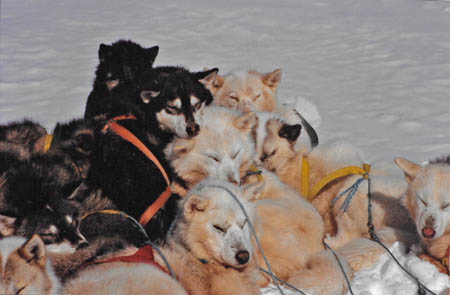In this Post
From the
Editor
The Aboriginal Dog as a Domesticate
Neuroanatomy and Behavior Correlations
Specialized Sledge Dogs Accompanied Inuit Dispersal Across the North American Arctic
Cold Case Reopened and Other QIMMEQ News
Langsomt på Svalbard (Slowly on Svalbard)
Frossen Frihe (Frozen Freedom)
Restoring a Historic Nansen Sledge
IMHO: A View from Across the Divide
The Aboriginal Dog as a Domesticate
Neuroanatomy and Behavior Correlations
Specialized Sledge Dogs Accompanied Inuit Dispersal Across the North American Arctic
Cold Case Reopened and Other QIMMEQ News
Langsomt på Svalbard (Slowly on Svalbard)
Frossen Frihe (Frozen Freedom)
Restoring a Historic Nansen Sledge
IMHO: A View from Across the Divide
Navigating This Site
Index of articles by subject
Index of Journal editions by
volume number
Index of PostScript editions by publication number
Search The Fan Hitch
Articles to download and print
Ordering Ken MacRury's Thesis
Our comprehensive list of resources
Defining the Inuit Dog
Talk to The Fan Hitch
Shop & Support Center
The Fan Hitch home page
Index of articles by subject
Index of Journal editions by
volume number
Index of PostScript editions by publication number
Search The Fan Hitch
Articles to download and print
Ordering Ken MacRury's Thesis
Our comprehensive list of resources
Defining the Inuit Dog
Talk to The Fan Hitch
Shop & Support Center
The Fan Hitch home page
Editor's/Publisher's
Statement
Editor: Sue Hamilton
Webmaster: Mark Hamilton
The Fan Hitch Website and
Publications of the Inuit Sled Dog– the
quarterly Journal (retired
in 2018) and PostScript – are dedicated to the
aboriginal landrace traditional Inuit Sled
Dog as well as related Inuit culture and
traditions.
PostScript is
published intermittently as
material becomes available. Online access
is free at: https://thefanhitch.org.
PostScript welcomes your
letters, stories, comments and
suggestions. The editorial staff reserves
the right to edit submissions used for
publication.
Contents of The Fan Hitch Website and its publications are protected by international copyright laws. No photo, drawing or text may be reproduced in any form without written consent. Webmasters please note: written consent is necessary before linking this site to yours! Please forward requests to Sue Hamilton, 55 Town Line Rd., Harwinton, Connecticut 06791, USA or mail@thefanhitch.org.
Contents of The Fan Hitch Website and its publications are protected by international copyright laws. No photo, drawing or text may be reproduced in any form without written consent. Webmasters please note: written consent is necessary before linking this site to yours! Please forward requests to Sue Hamilton, 55 Town Line Rd., Harwinton, Connecticut 06791, USA or mail@thefanhitch.org.

Greenland Dogs resting on the ice. Photo: Hamilton
Cold Case Reopened: Finding Clues to Recurrent Mass Mortalities
in Greenland Sled Dogs (Canis lupus familiaris borealis)
and
other QIMMEQ news
Cold case reopened: finding clues to recurrent mass mortalities in Greenland sled dogs (Canis lupus familiaris borealis) was published in Nature (July 2019, Volume 42, Issue 7, pp 1411–1413 under Polar Biology. As Springer, the publisher, wanted a huge sum to retrieve it in its entirely, and then over $800 for the right to reproduce it in The Fan Hitch PostScript, I decided to write to the lead author, Emilie U. Andersen-Ranberg, DVM, to ask for a copy. It is briefly summarized below:
Disease occurrences, such as canine distemper virus (CDV) in Greenland Dogs, have been recognized and described for a couple of hundred years.Emilie U. Andersen-Ranberg, DVM has published other papers on the Greenland Dog as well (see these and other papers at the QIMMEQ website here). In addition to a copy of the paper, she included a heads up on other QIMMEQ projects:
“Historically, CDV was appointed as the main cause…However, reports concerning the symptomatic clinical appearance among the sled dogs describe a set of characteristic symptoms deviating from those typical for CDV in western dog populations.”Distemper virus is known to exist in other arctic species which are hunted as food sources for dogs (and people): polar bear, arctic fox and arctic wolf, seals. Their seasonal migratory patterns are studied to correlate their being hunted with the cycles of distemper epizootics (disease that is temporarily prevalent and widespread in an animal population) in Greenland Dogs. Additionally, and in these modern times, another cause given for these outbreaks was given as “suboptimal vaccine regimens” .
“…in order to attenuate disease spread, further studies into sled dog health and the epizootiology of recurrent outbreaks are crucial.”It is important to identify “viral species and strain identification” to benefit effective vaccination. Additionally increased veterinary health surveillance, general support for Greenland Dogs is essential for their protection.
- an upcoming photo and information book about the Greenlandic sleddog edited by the Arctic photographer and biologist Carsten Egevang who has previously published several other beautiful books about Greenland.
- an international conference in Nuuk in December, gathering most members from Qimmeq incl. Qimmeq Health as well as other stakeholders.
- an information campaign about parasite control in sleddogs
- field work sampling in Ilulissat regarding the health and physiology of sleddogs, next month.
- initiation of a greater scale solution to provide health care assistance in the sleddog area of Greenland
As an aside, please take note of how these authors taxonomically identify the Greenland Dog as Canis lupus familiaris borealis. From Darwin’s time until fairly recently, the Inuit Sled Dog (the Canadian Inuit Dog and the Greenland Inuit Dog) was known scientifically as Canis familiaris borealis. Then taxonomists, in identifying domestic dogs in relation to the wolf, Canis lupus, re-named them as a whole Canis lupus familiaris. I bear no strong opinion either way about the domestic dog’s name change. However, it is important to me that scientists identify aboriginal dogs as distinct from cultured dog breeds, recognizing these landraces as unique in the canid world. Sadly, not all scientists are committed to this concept.